What's New Under The Sun
Madison Historic Dial Returns
Monday, 13 October 2025 22:49
 On October 4, 2025 Madison Historical Society of Ohio was able to have their sundial returned after 32 years, when in 1993 it was moved to the lawn of Lake County Courthouse to reduce the chance of vandalism. The sundial was originally placed at Madison Home 100 years ago on Saturday, October 24, 1925 during a conference of the Women's Relief Society. From 1904 to 1962 the state ran this...
On October 4, 2025 Madison Historical Society of Ohio was able to have their sundial returned after 32 years, when in 1993 it was moved to the lawn of Lake County Courthouse to reduce the chance of vandalism. The sundial was originally placed at Madison Home 100 years ago on Saturday, October 24, 1925 during a conference of the Women's Relief Society. From 1904 to 1962 the state ran this...
Elements of Dialing Course - 2025
Monday, 15 September 2025 19:42
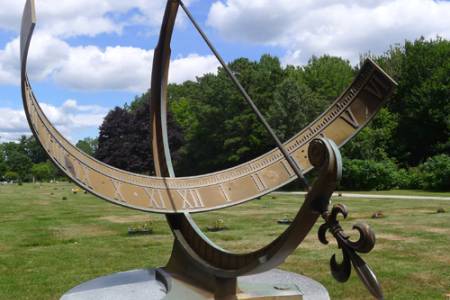 NASS is pleased to announce the upcoming fifth instance of Elements of Dialing, our introductory course about sundials, their history, and the science that makes them work. The free 12-lesson course, intended for those are new to sundialing, runs from 27 October 2025 until 26 April 2026. The course instructor is Robert Kellogg, NASS Vice President and Sundial Registrar. Bob will be...
NASS is pleased to announce the upcoming fifth instance of Elements of Dialing, our introductory course about sundials, their history, and the science that makes them work. The free 12-lesson course, intended for those are new to sundialing, runs from 27 October 2025 until 26 April 2026. The course instructor is Robert Kellogg, NASS Vice President and Sundial Registrar. Bob will be...
Sun Queen of World War II
Thursday, 11 September 2025 23:11
 A Hungarian born American scientist, Mária Telkes (1900-1995), was called "The Sun Queen" and among other honors, was postmousthly inducted into the National Inventors Hall of Fame. She lived to 95 and for most of her life developed solar power in a variety of forms.
Trained as a biophysicist, she worked for Westinghouse Electrical and Manufacturing Company in Pittsburgh, PA, where she...
A Hungarian born American scientist, Mária Telkes (1900-1995), was called "The Sun Queen" and among other honors, was postmousthly inducted into the National Inventors Hall of Fame. She lived to 95 and for most of her life developed solar power in a variety of forms.
Trained as a biophysicist, she worked for Westinghouse Electrical and Manufacturing Company in Pittsburgh, PA, where she...
2025 Conference -Ottawa
Thursday, 28 August 2025 23:25
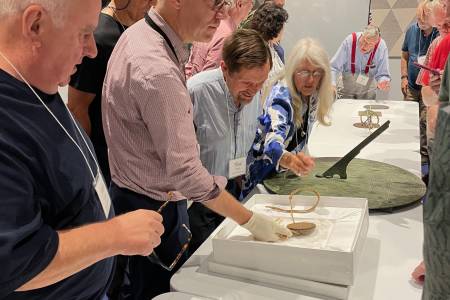 The annual NASS Conference was held 7-10 August, 2025 in Ottawa. As usual, the conference began late Thursday afternoon with an introduction social and a "grab bag give away", taking your chances with tickets to win the bag's prize. Will Grant was the final winner of the Walton Double Planar Polar Sundial, but Paul Ulbrich beat the statistic odds and won this prize three times,...
The annual NASS Conference was held 7-10 August, 2025 in Ottawa. As usual, the conference began late Thursday afternoon with an introduction social and a "grab bag give away", taking your chances with tickets to win the bag's prize. Will Grant was the final winner of the Walton Double Planar Polar Sundial, but Paul Ulbrich beat the statistic odds and won this prize three times,...
Prosciutto di Portici Sundial's Owner
Tuesday, 10 June 2025 18:51
 Prosciutto di Portici (Ham) Sundial
Photo: Getty Images
The Prosciutto di Portici Sundial, more often called the Portici Ham Sundial, dates from the first century somewhere between 8 BCE to 79 CE. This small silvered bronze dial was uncovered on 11 June, 1755 in the ruins of Herculaneum (current day Portici) in the "Villa of the Papyri", buried in...
Prosciutto di Portici (Ham) Sundial
Photo: Getty Images
The Prosciutto di Portici Sundial, more often called the Portici Ham Sundial, dates from the first century somewhere between 8 BCE to 79 CE. This small silvered bronze dial was uncovered on 11 June, 1755 in the ruins of Herculaneum (current day Portici) in the "Villa of the Papyri", buried in...
Hamilton Dial Dedicated
Friday, 06 June 2025 21:01
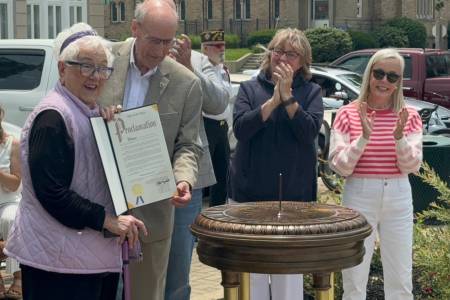 Sundial dedication May 31, 2025. At left is Kathleen Stuckey Fox, with the City Proclamation presented by Mayor Pat Moeller and City Council on-lookers Carla Fiehrer and Susan Vaughn offering congratulations.
On May 31, 2025 at 1pm, the Hamilton, Ohio, sundial (NASS Sundial Registry #1109) was re-dedicated in Monument Park. Originally dedicated in 1941 to the...
Sundial dedication May 31, 2025. At left is Kathleen Stuckey Fox, with the City Proclamation presented by Mayor Pat Moeller and City Council on-lookers Carla Fiehrer and Susan Vaughn offering congratulations.
On May 31, 2025 at 1pm, the Hamilton, Ohio, sundial (NASS Sundial Registry #1109) was re-dedicated in Monument Park. Originally dedicated in 1941 to the...
Frans Maes Received a Royal Decoration
Monday, 24 March 2025 21:33
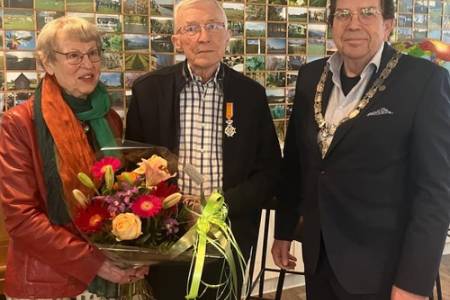 Several years ago Frans decided to write the course on sundials that included self assessment questions to force students not only to read the text, but to internalize the concepts. And a final submittal question "not necessarily a difficult question, but: no answer, no new lesson." Thus Frans Maes began writing lessons and sending them out to students.
NASS has now used his material to create...
Several years ago Frans decided to write the course on sundials that included self assessment questions to force students not only to read the text, but to internalize the concepts. And a final submittal question "not necessarily a difficult question, but: no answer, no new lesson." Thus Frans Maes began writing lessons and sending them out to students.
NASS has now used his material to create...
Pros and Cons of Daylight Savings Time
Monday, 24 March 2025 15:37
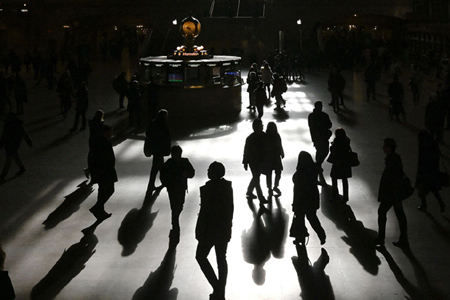 In a 24 March 2025 article from the on-line Science Advisor (American Association for the Advancement of Science) Phie Jacobs summarizes the "great debate" of the yearly shift from standard time to daylight savings time. In January 2025 the US Senate introduced the Sunshine Protection Act to permanently have daylight savings time year round. Certainly 54% of Americans do not like the...
In a 24 March 2025 article from the on-line Science Advisor (American Association for the Advancement of Science) Phie Jacobs summarizes the "great debate" of the yearly shift from standard time to daylight savings time. In January 2025 the US Senate introduced the Sunshine Protection Act to permanently have daylight savings time year round. Certainly 54% of Americans do not like the...
Native American Moon Alignment Ring
Friday, 21 March 2025 19:26
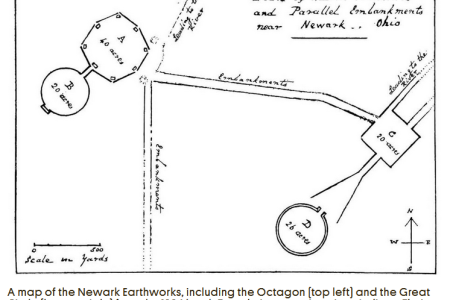 Perhaps the most famous alignment circle in the United States is the Cahokia Woodhenge near St. Louis constructed between 700-1400 CE by Cahokia Indigenous native Americans. But there were an estimated 10,000 other earthen mounds that once were scatter across the mid-west..
In an article from Atlas Obscura (https://www.atlasobscura.com/articles/octagon-earthworks-ohio) by Olivia Young on March...
Perhaps the most famous alignment circle in the United States is the Cahokia Woodhenge near St. Louis constructed between 700-1400 CE by Cahokia Indigenous native Americans. But there were an estimated 10,000 other earthen mounds that once were scatter across the mid-west..
In an article from Atlas Obscura (https://www.atlasobscura.com/articles/octagon-earthworks-ohio) by Olivia Young on March...
Hamilton Dial under Restoration
Friday, 21 March 2025 18:37
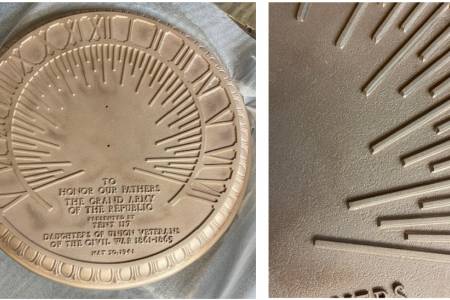 The Hamilton dial is in the restorative care of Jarrett and Celene Hawkins (Hawkins & Hawkins Custom, LLC in Cincinnati Ohio https://www.studio-hawkins.com/) in preparation for the dial's dedication on Saturday, May 31, 2025.
The face of the Hamilton Grand Army of the Republic (GAR) sundial has been cleaned and bead-blasted showing the dial as it was cast 84 years ago. In the process,...
The Hamilton dial is in the restorative care of Jarrett and Celene Hawkins (Hawkins & Hawkins Custom, LLC in Cincinnati Ohio https://www.studio-hawkins.com/) in preparation for the dial's dedication on Saturday, May 31, 2025.
The face of the Hamilton Grand Army of the Republic (GAR) sundial has been cleaned and bead-blasted showing the dial as it was cast 84 years ago. In the process,...
VSSC Space Museum gets Polar Sundial
Tuesday, 17 December 2024 23:47
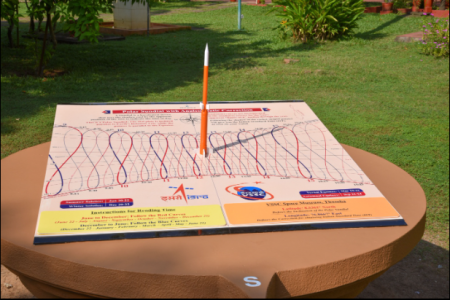 In November 2024, a team consisting of members from SPL, TTDG and CMD of VSSC successfully designed and installed an accurate and fully functional sundial at the Rocket Garden of VSSC Space Museum, Thumba (8.53°N, 76.86°E). Following a space theme, the vertical gnomon is a 3-stage rocket that casts its daily and seasonal shadow on a dial face 1 1/2 meters by 1 meter. The the sundial face...
In November 2024, a team consisting of members from SPL, TTDG and CMD of VSSC successfully designed and installed an accurate and fully functional sundial at the Rocket Garden of VSSC Space Museum, Thumba (8.53°N, 76.86°E). Following a space theme, the vertical gnomon is a 3-stage rocket that casts its daily and seasonal shadow on a dial face 1 1/2 meters by 1 meter. The the sundial face...
Historic Sundials of Andalusia
Saturday, 16 November 2024 00:07
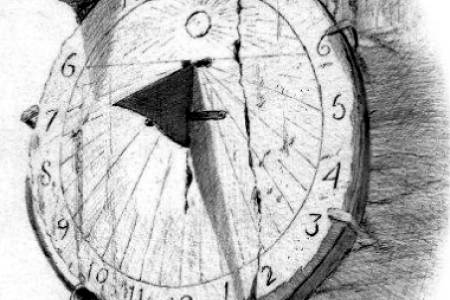 Esteban Martínez Almirón has published a new book Historical Sundials: Forgotten Andalusian Treasures (Relojes de Sol Históricos Tesoros Andaluces Olvidados) In it he reviews over 400 sundials from the Andalucian region of southern Spain Originally to celebrate the 25th year of the website https://relojandalusi.org/
Esteban Martínez Almirón began showing his sundial drawings on the site....
Esteban Martínez Almirón has published a new book Historical Sundials: Forgotten Andalusian Treasures (Relojes de Sol Históricos Tesoros Andaluces Olvidados) In it he reviews over 400 sundials from the Andalucian region of southern Spain Originally to celebrate the 25th year of the website https://relojandalusi.org/
Esteban Martínez Almirón began showing his sundial drawings on the site....
Sundial Wrist Watch
- Details
- Hits: 15192
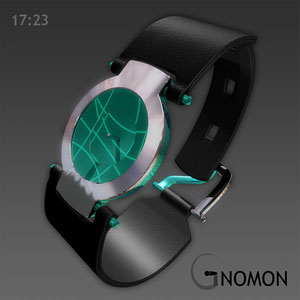 A novel wrist watch is being proposed which uses LED's instead of the sun to cast shadows. Proposed by an individual named Anders who lives in Sweden, the watch, which is still just a concept, is read much like a conventional analog watch. But instead of an hour hand and a minute hand, it uses LEDs which rotate around the outer ring of the dial and shine on a small gnomon at the center of the watch. One LED casts a shadow for telling hours and another for telling minutes. It is too soon to tell whether this concept watch will prove popular enough to manufacture.
A novel wrist watch is being proposed which uses LED's instead of the sun to cast shadows. Proposed by an individual named Anders who lives in Sweden, the watch, which is still just a concept, is read much like a conventional analog watch. But instead of an hour hand and a minute hand, it uses LEDs which rotate around the outer ring of the dial and shine on a small gnomon at the center of the watch. One LED casts a shadow for telling hours and another for telling minutes. It is too soon to tell whether this concept watch will prove popular enough to manufacture.
Parasol Sundial
- Details
- Hits: 11968
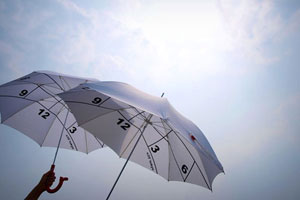 Primarily an industrial designer, Kota Nezu has designed a parasol for people who use their umbrellas for shade as well as staying dry.
Primarily an industrial designer, Kota Nezu has designed a parasol for people who use their umbrellas for shade as well as staying dry.
With just a little bit of effort, Nezu's dial can be used to tell the approximate time of day and season of the year. The parasol comes equipped with a small compass to aid in lining things up. And even though a true sundial aficionado might point out that a proper dial has to be designed for a specific latitude, this handly umbrella is sure to be a conversation starter come rain or shine.
City of Bowie Announces Sundial Winner
- Details
- Hits: 9904
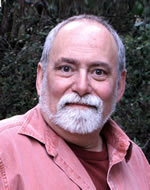 Gino and Judith Schiavone, members of the North American Sundial
Gino and Judith Schiavone, members of the North American Sundial Society, are winners of the City of Bowie sundial contest to build and install a dial in front of the New City Hall under now construction. The value of the project is $90,000. Completion is expected in Oct 2010.
Society, are winners of the City of Bowie sundial contest to build and install a dial in front of the New City Hall under now construction. The value of the project is $90,000. Completion is expected in Oct 2010.
Carefree Dial gets a Sunburst
- Details
- Hits: 8274
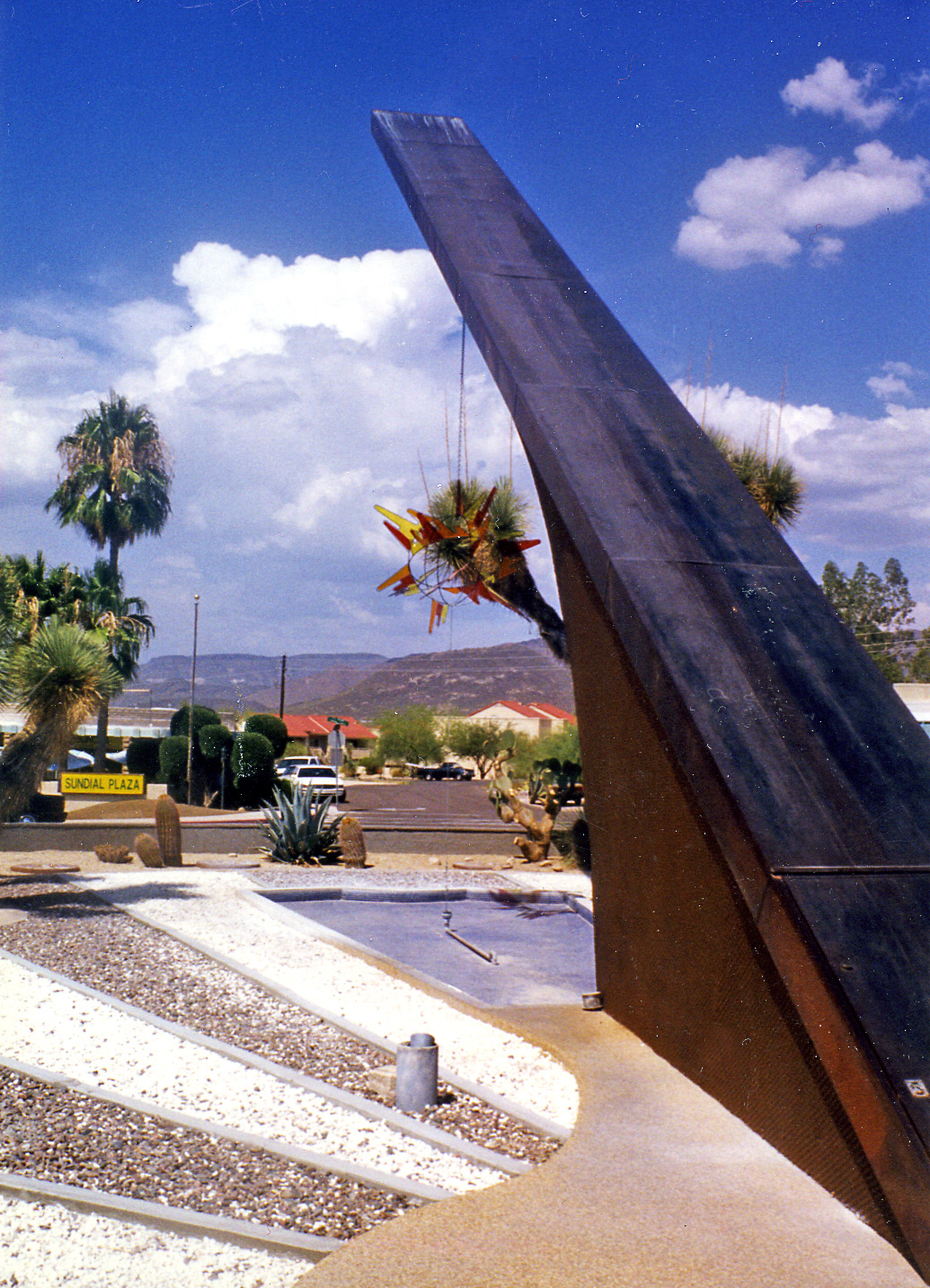 The first sundial in the NASS Registry is the dial from Carefree, Arizona. This 35 foot tall dial was designed by architect Joe Wong and solar engineer John Yellott and when built in 1959 was considered the second largest sundial in the world. You can see in the accompanying photo that hanging midway along the sundial's gnomon is a garish colored ball, a "Sunburst". [It is partially hidden by a background palm tree.] This structure was part of the original design. From the on-line Carefree City SunTimes, editor-in-chief Kathryn Miller brings us the story of its origin, demise, and now its restoration. The seven-foot wide wrought iron Sunburst has not been on the gnomon for the last 20 years. From Miller's article, "As the story was told by Carefree Vice Mayor John Crane in his March CITYSunTimes column, “The Joe Wong designed Sunburst enjoyed a short life. In 2004, when the Sunburst was determined to be beyond repair it was donated to the Cave Creek Museum where it resided outside for many years."
The first sundial in the NASS Registry is the dial from Carefree, Arizona. This 35 foot tall dial was designed by architect Joe Wong and solar engineer John Yellott and when built in 1959 was considered the second largest sundial in the world. You can see in the accompanying photo that hanging midway along the sundial's gnomon is a garish colored ball, a "Sunburst". [It is partially hidden by a background palm tree.] This structure was part of the original design. From the on-line Carefree City SunTimes, editor-in-chief Kathryn Miller brings us the story of its origin, demise, and now its restoration. The seven-foot wide wrought iron Sunburst has not been on the gnomon for the last 20 years. From Miller's article, "As the story was told by Carefree Vice Mayor John Crane in his March CITYSunTimes column, “The Joe Wong designed Sunburst enjoyed a short life. In 2004, when the Sunburst was determined to be beyond repair it was donated to the Cave Creek Museum where it resided outside for many years."
Eventually the museum returned the rusting icon to the City of Carefree, ending up in the Town garage. Miller's article now reports it's restoration that was completed in March 2021: "...[Back in] 2019, a Carefree resident, who prefers to remain anonymous, took it upon himself to return this misplaced, but not forgotten, historic and iconic art piece to its rightful place. Now, a reincarnated Sunburst, dimensionally identical to the original, but with improved design and modern materials, holds a place of honor in the Town center, once again celebrating the desert sunshine and casting its glow beneath the Sundial."
Perhaps an indicator of the times with the urge to turn night into day, this Sunburst that hangs on the gnomon is now electrified and illuminate with LED lights, blending in with the LED lighting of surrounding cactus in ithe plaza.
Monumental Error?
- Details
- Hits: 10954
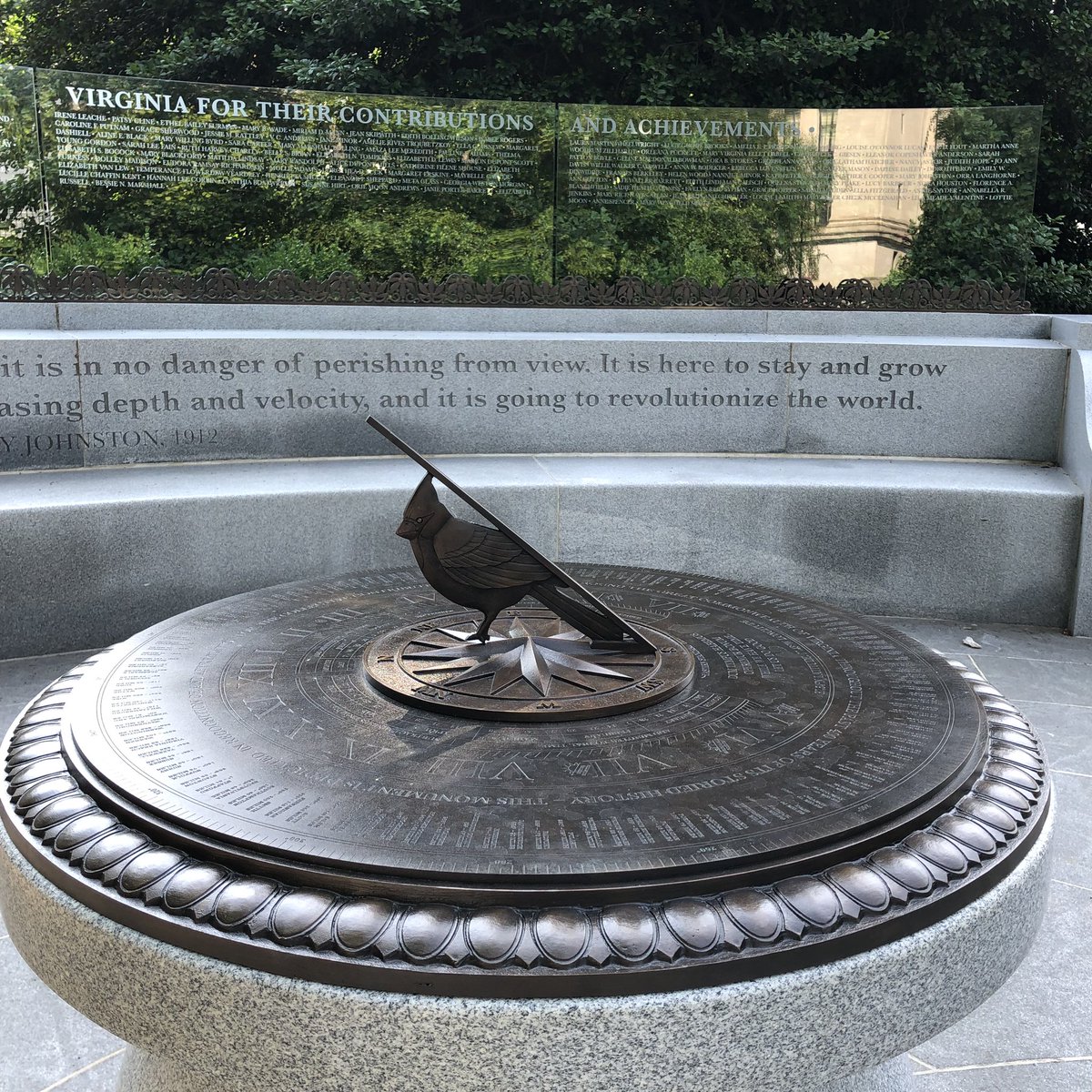 On the State Capitol grounds in Richmond Virginia the Women's Monument was unveiled on Oct 14, 2019 as part of celebrating the 100th anniversary of the 19th amendment that gave women the right to vote. The Women's Monument, commissioned by the Virginia Department of General Services, negotiated two contracts with local artists on behalf of the Virginia Women's Monument Commission who has raised more the $3.7 million for this monument. The result is a large circular plaza with 7 life sized bronze statues of influential Virginia women during the last 400years. The monument will eventually feature 5 more life-size bronze statues. The statues are backed by a glass wall with the inscribed names of 230 infuential Virginia women on the Wall of Honor.. The monument is a work in progress and intends to not only complete the last 5 statues, but add other women's names to the Wall of Honor.
On the State Capitol grounds in Richmond Virginia the Women's Monument was unveiled on Oct 14, 2019 as part of celebrating the 100th anniversary of the 19th amendment that gave women the right to vote. The Women's Monument, commissioned by the Virginia Department of General Services, negotiated two contracts with local artists on behalf of the Virginia Women's Monument Commission who has raised more the $3.7 million for this monument. The result is a large circular plaza with 7 life sized bronze statues of influential Virginia women during the last 400years. The monument will eventually feature 5 more life-size bronze statues. The statues are backed by a glass wall with the inscribed names of 230 infuential Virginia women on the Wall of Honor.. The monument is a work in progress and intends to not only complete the last 5 statues, but add other women's names to the Wall of Honor.
In the center of the plaza on a wide circular pedestal is a bronze sundial. In addition to the normal dial furniture of compass rose inscriptions, site latitude & longitude, and a chapter ring with the hours from 5am to 7pm there is additional information: points of locations in Virginia are shown around the dial in the outer chapter ring. Each location is listed by name, azimuth, and distance from the Capitol site.
With all the work to create this magnificent monument to women there is a monumental nit pick. At azimuth 354 deg and 108 miles away is "Loudon". Locals immediatedly spotted the typo for Loudoun County, which according to the official county history recorded: "In 1757, by act of the Virginia House of Burgesses, Fairfax County was divided. The western portion was named Loudoun for John Campbell, the fourth earl of Loudoun, a Scottish nobleman who served as commander-in-chief for all British armed forces in North America and titular governor of Virginia from 1756 to 1759."
In spite of the typo, the dial is an impressive work of art approximate one meter in diameter.
Photo Credit: Sara Hunt, Virginia Capitol and AA Communications
Sundial from the Pomeroy Class of 1927
- Details
- Hits: 15507
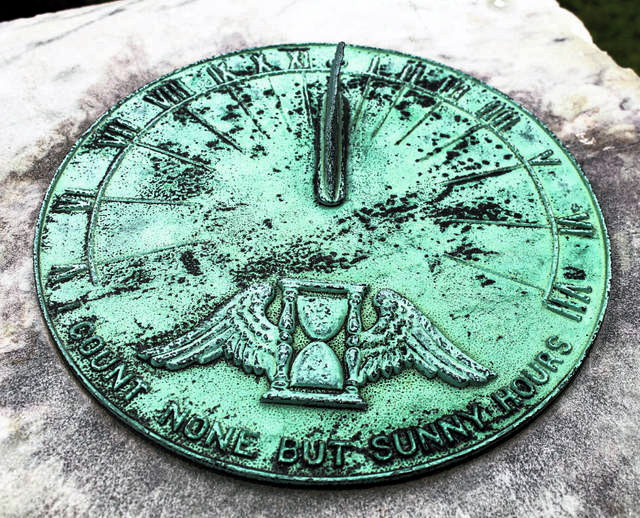 It is a small memorial sundial, only about a foot in diameter. The polished bronze face has aged with time as have the students who gave that dial to the Pomeroy Seniior High School. The sundial gifted by the graduating class of 1927 was placed on the front lawn of the school where it remained for more than 90 years. According to a short article by Sara Hawley [https://www.mydailysentinel.com/news/42283/phs-sundial-has-new-home ] "Alumni remember that area as being 'out of bounds' to them as students. They could never put their hands on the sundial - only viewing it from afar."
It is a small memorial sundial, only about a foot in diameter. The polished bronze face has aged with time as have the students who gave that dial to the Pomeroy Seniior High School. The sundial gifted by the graduating class of 1927 was placed on the front lawn of the school where it remained for more than 90 years. According to a short article by Sara Hawley [https://www.mydailysentinel.com/news/42283/phs-sundial-has-new-home ] "Alumni remember that area as being 'out of bounds' to them as students. They could never put their hands on the sundial - only viewing it from afar."
But now the school is no longer used and is being sold. The Pomeroy Alumni Association began to make plans to relocate their treasured sundial, "The sundial had previously survived several floods when it was located in front of the school. After looking at several locations, it was decided to place it on the foundation of the old bandstand in the Beech Grove Cemetery."
Remembering 9/11 at Tampa Memorial
- Details
- Hits: 13607
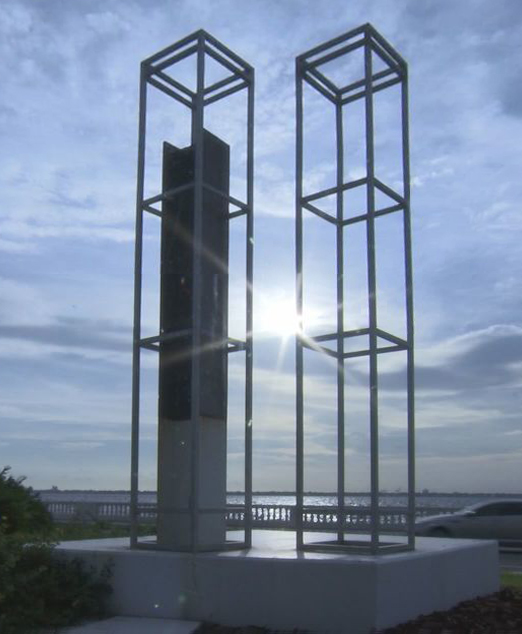 It has been 17 years since 2001 when on September 11th terrorists attacked the world trade center and the Pentagon. To memorialize this tragic event artifacts from the Word Trade Center are now in 1,100 cities, large and small, across the country that have received portions of the Trade Center wreckage from the Port Authority of New York. In Tampa along Bayshore Boulevard near Bay Boulevard is a striking memorial. Here is a World Trade Center in miniature, represented as two tower outlines, matching the orientation and scale of the site in New York City. Thin aluminum members rise from the memorial base, tracing the placement, material, and proportions of the twin towers. The memorial is one one-hundreth the scale of the actual towers and site. The memorial was dedicated on Friday, September 9th, 2018.
It has been 17 years since 2001 when on September 11th terrorists attacked the world trade center and the Pentagon. To memorialize this tragic event artifacts from the Word Trade Center are now in 1,100 cities, large and small, across the country that have received portions of the Trade Center wreckage from the Port Authority of New York. In Tampa along Bayshore Boulevard near Bay Boulevard is a striking memorial. Here is a World Trade Center in miniature, represented as two tower outlines, matching the orientation and scale of the site in New York City. Thin aluminum members rise from the memorial base, tracing the placement, material, and proportions of the twin towers. The memorial is one one-hundreth the scale of the actual towers and site. The memorial was dedicated on Friday, September 9th, 2018.
Interviewed by Fox 13 News of Tampa, John Thompson of Wilder Architect who designed the memorial explained, "So we put [the steel I-Beam from the Tower, setting] it standing straight like the column in the North Tower, symbolically." Thompson continued, "The column for the World Trade Center acts as a sundial...There's a portion of concrete base that in the morning of September 11th when the shadow of the column hits that particular piece of concrete, that's the [time of] impact of the plane on the north tower. As the morning carries on, when the column shadow falls off the concrete, that's when the building fell." American Airlines Flight 11 hit the World Trade Center at 8:46am. After burning for 102 minutes, the north tower of the World Trade Center collapsed, killing approximately 1,400 people.
According the Fox 13 News, "It's a place where joggers stop to pray and groups stop to reflect, such as the Bayshore Patriots, an organization where members stand at its corner every Friday to wave the U.S. flag at commuters. Thompson invites everyone to come out the morning of 9/11 and see the sundial."
Read more at:
http://www.fox13news.com/news/local-news/memorial-functions-as-a-sundial-tells-story-of-911#/
http://www.publicartarchive.org/node/54627
https://www.tampagov.net/news/city-tampa-dedicate-911-world-trade-center-artifact-memorial-be-installed-patriots-corner
Forest Park Memorial Dial
- Details
- Hits: 12897
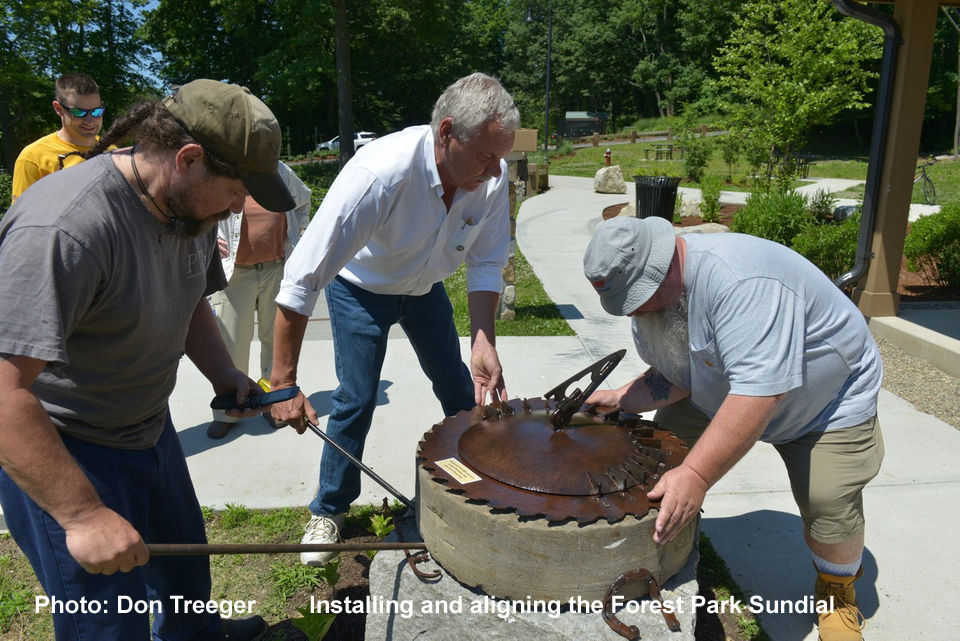 On June 6th 2018, an interest memorial sundial was donated to the Clifford A. Phaneuf Environmental Center at Forest Park, MA just off U.S. 91 and a stone's throw from the Connecticut River. According to Mass Live (https://www.masslive.com/news/index.ssf/2018/06/new_sundial_at_forest_park_env.html), "During the public ceremony, the sculpted sundial was donated by the family of retired Hampden County Housing Court Judge Edward C. Peck Jr. and dedicated in memory of Peck's late wife, Ruth Mahoney Peck." The Peck family commissioned sculptor James Kitchen who created a run-patina steel sundial with the base of an old mill circular saw blade and setting a pipe wrench and ice skate blade welded together as gnomon. According to Burt Freedman, a retired teacher of the Environmental Center for Our Schools at Forest Park, the dial provides references to the industrial and agricultural history of Springfield and Forest Park.
On June 6th 2018, an interest memorial sundial was donated to the Clifford A. Phaneuf Environmental Center at Forest Park, MA just off U.S. 91 and a stone's throw from the Connecticut River. According to Mass Live (https://www.masslive.com/news/index.ssf/2018/06/new_sundial_at_forest_park_env.html), "During the public ceremony, the sculpted sundial was donated by the family of retired Hampden County Housing Court Judge Edward C. Peck Jr. and dedicated in memory of Peck's late wife, Ruth Mahoney Peck." The Peck family commissioned sculptor James Kitchen who created a run-patina steel sundial with the base of an old mill circular saw blade and setting a pipe wrench and ice skate blade welded together as gnomon. According to Burt Freedman, a retired teacher of the Environmental Center for Our Schools at Forest Park, the dial provides references to the industrial and agricultural history of Springfield and Forest Park.
The Hour Lines are short vanes of steel raised about 1" above the circular saw blade. A slight dome extends from the hour line circle to the center where the sundial gnomon sets. Although the 6am-6pm line meets the base of the gnomon, the fact that the gnomon is raised 2 or more inches above the saw blade, sets the virtual foot of the gnomon far back of the 6-6 line. Thus, although the sundial is esthetically beautiful and represents history of the area, perhaps it tells time with considerably more error than expected from the Equation of Time. [No longitude correction is provided, resulting in nearly 10 minutes of constant error.]
Arc of Memory
- Details
- Hits: 13175
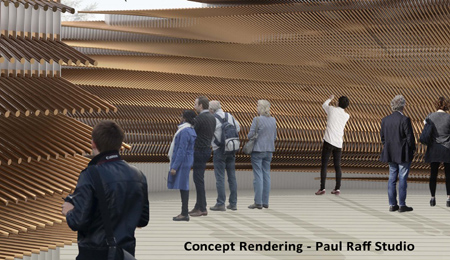 A memorial, the Arc of Memory, will be completed in 2018 on the west side of the Garden of Provinces and Territories in Ottawa. The design by Paul Raff's Sutdio is a "living calendar". Raff described the memorial as a way to “honour the 8 million Canadians that can trace their origins to countries that suffered oppressive regimes of communism by creating an instrument of memory.” In essence Raff is designing a huge digital sundial (or as he calls it, a "three dimensional calendar"). According to Erin Dommely of Azure Magazine, the memorial is constructed of two curving walls 4 x 21 meters containing 4,000 short bronze rods arranged in 12 dense rows across a series of 365 stainless steel fins. Erin describes the Arc of Memory's principle of having each rod uniquely angled towards the sun, whereby each hour of the day is illuminated each day of the year.
A memorial, the Arc of Memory, will be completed in 2018 on the west side of the Garden of Provinces and Territories in Ottawa. The design by Paul Raff's Sutdio is a "living calendar". Raff described the memorial as a way to “honour the 8 million Canadians that can trace their origins to countries that suffered oppressive regimes of communism by creating an instrument of memory.” In essence Raff is designing a huge digital sundial (or as he calls it, a "three dimensional calendar"). According to Erin Dommely of Azure Magazine, the memorial is constructed of two curving walls 4 x 21 meters containing 4,000 short bronze rods arranged in 12 dense rows across a series of 365 stainless steel fins. Erin describes the Arc of Memory's principle of having each rod uniquely angled towards the sun, whereby each hour of the day is illuminated each day of the year.
The two walls are split at the winter solstice and "On the darkest day of the year the design would invite visitors to step through in a metaphorical journey from darkness and oppression to lightness and liberty.”
Read more at: http://www.azuremagazine.com/article/memorial-victims-communism-design-revealed-ottawa/
